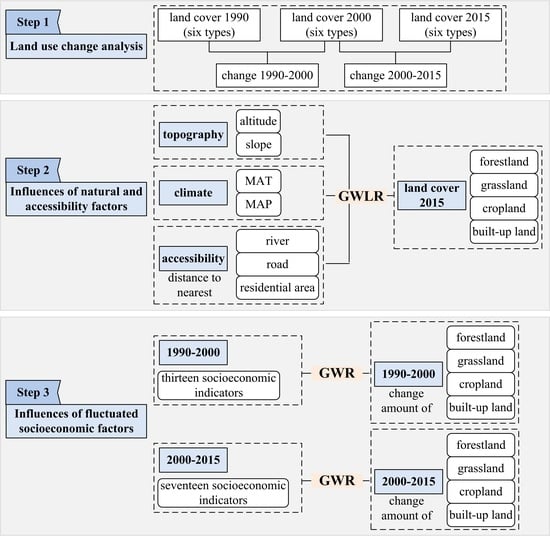Driving Factors of Land Change in China’s Loess Plateau: Quantification Using Geographically Weighted Regression and Management Implications
Abstract
1. Introduction
2. Materials and Methods
2.1. Study Area
2.2. Data
2.2.1. Land-Cover Data
2.2.2. Topography, Climate and Accessibility Data
2.2.3. Socioeconomic Data
2.3. Geographically Weighted Regression Method
3. Results
3.1. Land-Use and Land-Cover Change
3.2. Internal Determinants of Land-Use Patterns Based on GWLR
3.3. External Socioeconomic Drivers of Land Change Based on GWR
3.3.1. Driving Factors of Land Change during 1990–2000
3.3.2. Driving Factors of Land Change during 2000–2015
4. Discussion
4.1. Land Degradation and Restoration in the Semiarid Loess Plateau
4.2. Better Performance of GW Method Compared with Global-Level Models
4.3. Implications for Land-Change Modeling and Land Management
4.4. Caveats and Ways Ahead
5. Conclusions
Supplementary Materials
Author Contributions
Funding
Acknowledgments
Conflicts of Interest
References
- Verburg, P.H.; Crossman, N.; Ellis, E.C.; Heinimann, A.; Hostert, P.; Mertz, O.; Nagendra, H.; Sikor, T.; Erb, K.H.; Golubiewski, N.; et al. Land system science and sustainable development of the earth system: A global land project perspective. Anthropocene 2015, 12, 29–41. [Google Scholar] [CrossRef]
- GLP. Global Land Project. Science Plan and Implementation Strategy; IGBP Report No. 53/IHDP Report No. 19; IGBP Secretariat: Stockholm, Sweden, 2005; 64p. [Google Scholar]
- Uhrqvist, O.; Linnér, B.O. Narratives of the past for Future Earth: The historiography of global environmental change research. Anthr. Rev. 2015, 2, 159–173. [Google Scholar] [CrossRef]
- Zhang, K.; Yu, Z.; Li, X.; Zhou, W.; Zhang, D. Land use change and land degradation in China from 1991 to 2001. Land Degrad. Dev. 2007, 18, 209–219. [Google Scholar] [CrossRef]
- Crossland, M.; Winowiecki, L.A.; Pagella, T.; Hadgu, K.; Sinclair, F. Implications of variation in local perception of degradation and restoration processes for implementing land degradation neutrality. Environ. Dev. 2018, 28, 42–54. [Google Scholar] [CrossRef]
- Stavi, I.; Lal, R. Achieving Zero Net Land Degradation: Challenges and opportunities. J. Arid. Environ. 2015, 112, 44–51. [Google Scholar] [CrossRef]
- UNCCD. United Nations Convention to Combat Desertification. Available online: https://www.unccd.int/ (accessed on 30 January 2020).
- Safriel, U. Land Degradation Neutrality (LDN) in drylands and beyond—Where has it come from and where does it go. Silva. Fenn. 2017, 51. [Google Scholar] [CrossRef]
- Chen, C.; Park, T.; Wang, X.H.; Piao, S.L.; Xu, B.D.; Chaturvedi, R.K.; Fuchs, R.; Brovkin, V.; Ciais, P.; Fensholt, R.; et al. China and India lead in greening of the world through land-use management. Nat. Sustain. 2019, 2, 122–129. [Google Scholar] [CrossRef]
- Fu, B.J.; Wang, S.; Liu, Y.; Liu, J.B.; Liang, W.; Miao, C.Y. Hydrogeomorphic ecosystem responses to natural and anthropogenic changes in the Loess Plateau of China. Annu. Rev. Earth Planet. Sci. 2017, 45, 223–243. [Google Scholar] [CrossRef]
- Findell, K.L.; Berg, A.; Gentine, P.; Krasting, J.P.; Lintner, B.R.; Malyshev, S.; Santanello, J.A.; Shevliakova, E. The impact of anthropogenic land use and land cover change on regional climate extremes. Nat. Commun. 2017, 8, 989. [Google Scholar] [CrossRef]
- Napton, D.E.; Auch, R.F.; Headley, R.; Taylor, J.L. Land changes and their driving forces in the Southeastern United States. Reg. Envir. Chang. 2009, 10, 37–53. [Google Scholar] [CrossRef]
- Lawler, J.J.; Lewis, D.J.; Nelson, E.; Plantinga, A.J.; Polasky, S.; Withey, J.C.; Helmers, D.P.; Martinuzzi, S.; Pennington, D.; Radeloff, V.C.; et al. Projected land-use change impacts on ecosystem services in the United States. Proc. Natl. Acad. Sci. USA 2014, 111, 7492–7497. [Google Scholar] [CrossRef] [PubMed]
- Zhou, X.Y.; Li, X.Q.; Dodson, J.; Yang, S.L.; Long, H.; Zhao, K.L.; Sun, N.; Yang, Q.; Liu, H.B.; Zhao, C. Zonal vegetation change in the Chinese Loess Plateau since MIS 3. Paleogeogr. Paleoclimatol. Paleoecol. 2014, 404, 89–96. [Google Scholar] [CrossRef]
- Verburg, P.H.; van Eck, J.R.R.; de Nijs, T.C.M.; Dijst, M.J.; Schot, P. Determinants of land-use change patterns in the Netherlands. Environ. Plan. B-Plan. Des. 2004, 31, 125–150. [Google Scholar] [CrossRef]
- Cai, D.; Lin, M.; Zhang, W.L. Study on the driving force of regional land use change based on GWR model. In Proceedings of the 5th international conference on advanced computer science applications and technologies, Beijing, China, 25–26 March 2017; pp. 208–213. [Google Scholar] [CrossRef]
- Lambin, E.F.; Turner, B.L.; Geist, H.J.; Agbola, S.B.; Angelsen, A.; Bruce, J.W.; Coomes, O.T.; Dirzo, R.; Fischer, G.; Folke, C.; et al. The causes of land-use and land-cover change: Moving beyond the myths. Glob. Environ. Change-Human Policy Dimens. 2001, 11, 261–269. [Google Scholar] [CrossRef]
- van Vliet, J.; Magliocca, N.R.; Buchner, B.; Cook, E.; Rey Benayas, J.M.; Ellis, E.C.; Heinimann, A.; Keys, E.; Lee, T.M.; Liu, J.G.; et al. Meta-studies in land use science: Current coverage and prospects. Ambio 2016, 45, 15–28. [Google Scholar] [CrossRef] [PubMed]
- Shafizadeh-Moghadam, H.; Helbich, M. Spatiotemporal variability of urban growth factors: A global and local perspective on the megacity of Mumbai. Int. J. Appl. Earth Obs. Geoinf. 2015, 35, 187–198. [Google Scholar] [CrossRef]
- Chen, Y.Q.; Verburg, P.H. Modeling land use change and its effects by GIS. Ecologic Science 2000, 19, 1–7. [Google Scholar]
- Willemen, L.; Veldkamp, A.; Verburg, P.H.; Hein, L.; Leemans, R. A multi-scale modelling approach for analysing landscape service dynamics. J. Environ. Manage. 2012, 100, 86–95. [Google Scholar] [CrossRef]
- Aroengbinang, B.W.; Kaswanto. Driving force analysis of landuse and cover changes in Cimandiri and Cibuni Watersheds. In Proceedings of the 1st International Symposium on Lapan-Ipb Satellite (Lisat) for Food Security and Environmental Monitoring, Bogor, Indonesia, 25–26 November 2014; 24, pp. 184–188. [Google Scholar] [CrossRef]
- Arowolo, A.O.; Deng, X. Land use/land cover change and statistical modelling of cultivated land change drivers in Nigeria. Reg. Envir. Chang. 2017, 18, 247–259. [Google Scholar] [CrossRef]
- Maimaitijiang, M.; Ghulam, A.; Sandoval, J.S.O.; Maimaitiyiming, M. Drivers of land cover and land use changes in St. Louis metropolitan area over the past 40 years characterized by remote sensing and census population data. Int. J. Appl. Earth Obs. Geoinf. 2015, 35, 161–174. [Google Scholar] [CrossRef]
- An, K.J.; Lee, S.W.; Hwang, S.J.; Park, S.R.; Hwang, S.A. Exploring the non-stationary effects of forests and developed land within watersheds on biological indicators of streams using Geographically-Weighted Regression. Water 2016, 8, 120. [Google Scholar] [CrossRef]
- Rodrigues, M.; Jimenez-Ruano, A.; Pena-Angulo, D.; de la Riva, J. A comprehensive spatial-temporal analysis of driving factors of human-caused wildfires in Spain using Geographically Weighted Logistic Regression. J. Environ. Manag. 2018, 225, 177–192. [Google Scholar] [CrossRef] [PubMed]
- Brunsdon, C.; Fotheringham, A.S.; Charlton, M.E. Geographically Weighted Regression: A method for exploring spatial nonstationarity. Geogr. Anal. 1996, 28, 281–298. [Google Scholar] [CrossRef]
- Comber, A.J.; Brunsdon, C.; Radburn, R. A spatial analysis of variations in health access: Linking geography, socio-economic status and access perceptions. Int. J. Health Geogr. 2011, 10. [Google Scholar] [CrossRef]
- MacFadyen, S.; Hui, C.; Verburg, P.H.; Van Teeffelen, A.J.A. Quantifying spatiotemporal drivers of environmental heterogeneity in Kruger National Park, South Africa. Landsc. Ecol. 2016, 31, 2013–2029. [Google Scholar] [CrossRef]
- See, L.; Schepaschenko, D.; Lesiv, M.; McCallum, I.; Fritz, S.; Comber, A.; Perger, C.; Schill, C.; Zhao, Y.; Maus, V.; et al. Building a hybrid land cover map with crowdsourcing and geographically weighted regression. ISPRS-J. Photogramm. Remote Sens. 2015, 103, 48–56. [Google Scholar] [CrossRef]
- Wu, J.G. Book review: Rangeland degradation and recovery in China’s pastoral lands. Restor. Ecol. 2011, 19, 681–682. [Google Scholar] [CrossRef]
- Tsunekawa, A.; Liu, G.; Yamanaka, N.; Du, S. Restoration and development of the degraded Loess Plateau, China; Tsunekawa, A., Liu, G., Yamanaka, N., Du, S., Eds.; Springer: Tokyo, Japan, 2014. [Google Scholar]
- Zhao, G.J.; Mu, X.M.; Wen, Z.M.; Wang, F.; Gao, P. Soil erosion, conservation, and eco-environment changes in the Loess Plateau of China. Land Degrad. Dev. 2013, 24, 499–510. [Google Scholar] [CrossRef]
- Mao, D.H.; Luo, L.; Wang, Z.M.; Wilson, M.C.; Zeng, Y.; Wu, B.F.; Wu, J.G. Conversions between natural wetlands and farmland in China: A multiscale geospatial analysis. Sci. Total Environ. 2018, 634, 550–560. [Google Scholar] [CrossRef]
- Gao, W.W.; Zeng, Y.; Zhao, D.; Wu, B.F.; Ren, Z.Y. Land Cover Changes and Drivers in the Water Source Area of the Middle Route of the South-to-North Water Diversion Project in China from 2000 to 2015. Chin. Geogra. Sci. 2020, 30, 115–126. [Google Scholar] [CrossRef]
- Wu, B.F.; Zeng, Y.; Qian, J.K. Land Cover Atlas of the People’s Republic of China (1:1000, 000); SinoMaps Press: Beijing, China, 2017. [Google Scholar]
- Lü, Y.H.; Fu, B.J.; Feng, X.M.; Zeng, Y.; Liu, Y.; Chang, R.Y.; Sun, G.; Wu, B.F. A policy-driven large scale ecological restoration: Quantifying ecosystem services changes in the Loess Plateau of China. PLoS ONE 2012, 7, e31782. [Google Scholar] [CrossRef]
- Liang, W.; Fu, B.J.; Wang, S.; Zhang, W.B.; Jin, Z.; Feng, X.M.; Yan, J.W.; Liu, Y.; Zhou, S. Quantification of the ecosystem carrying capacity on China’s Loess Plateau. Ecol. Indic. 2019, 101, 192–202. [Google Scholar] [CrossRef]
- Zhou, D.; Zhao, S.; Zhu, C. Impacts of the sloping land conversion program on the land use/cover change in the Loess Plateau: A case study in Ansai county of Shaanxi province, China. J. Nat. Resour. 2011, 26, 1866–1878. [Google Scholar]
- Verburg, P.H.; Chen, Y.Q.; Veldkamp, T.A. Spatial explorations of land use change and grain production in China. Agric. Ecosyst. Environ. 2000, 82, 333–354. [Google Scholar] [CrossRef]
- Fotheringham, A.S.; Brunsdon, C.; Charlton, M. Geographically Weighted Regression: The analysis of spatially varying relationships; John Wiley & Sons: New York, NY, USA, 2003. [Google Scholar]
- Mayfield, H.J.; Lowry, J.H.; Watson, C.H.; Kama, M.; Nilles, E.J.; Lau, C.L. Use of geographically weighted logistic regression to quantify spatial variation in the environmental and sociodemographic drivers of leptospirosis in Fiji: a modelling study. Lancet Planet. Health 2018, 2, e223–e232. [Google Scholar] [CrossRef]
- Wu, L.; Deng, F.; Xie, Z.; Hu, S.; Shen, S.; Shi, J.; Liu, D. Spatial analysis of severe fever with Thrombocytopenia Syndrome Virus in China Using a Geographically Weighted Logistic Regression model. Int. J. Environ. Res. Public Health 2016, 13, 1125. [Google Scholar] [CrossRef]
- Lu, B.B.; Harris, P.; Charlton, M.; Brunsdon, C. The GWmodel R package: Further topics for exploring spatial heterogeneity using geographically weighted models. Geo-Spat. Inf. Sci. 2014, 17, 85–101. [Google Scholar] [CrossRef]
- Brunsdon, C.; Comber, L. An Introduction to R for Spatial Analysis & Mapping; Ashford Colour Press Ltd.: Great Britain, UK, 2015. [Google Scholar]
- Jia, X.X.; Yang, Y.; Zhang, C.C.; Shao, M.A.; Huang, L.M. A state-space analysis of soil organic carbon in China’s Loess Plateau. Land Degrad. Dev. 2017, 28, 983–993. [Google Scholar] [CrossRef]
- Chen, Y.; Wang, K.; Lin, Y.; Shi, W.; Song, Y.; He, X. Balancing green and grain trade. Nat. Geosci. 2015, 8, 739–741. [Google Scholar] [CrossRef]
- Liang, W.; Bai, D.; Wang, F.Y.; Fu, B.J.; Yan, J.P.; Wang, S.; Yang, Y.T.; Long, D.; Feng, M.Q. Quantifying the impacts of climate change and ecological restoration on streamflow changes based on a Budyko hydrological model in China’s Loess Plateau. Water Resour. Res. 2015, 51, 6500–6519. [Google Scholar] [CrossRef]
- Zhang, B.; Wu, P.; Zhao, X.; Wang, Y.; Gao, X. Changes in vegetation condition in areas with different gradients (1980-2010) on the Loess Plateau, China. Environ. Earth Sci. 2012, 68, 2427–2438. [Google Scholar] [CrossRef]
- Mao, D.; Wang, Z.; Wu, B.; Zeng, Y.; Luo, L.; Zhang, B. Land degradation and restoration in the arid and semiarid zones of China: Quantified evidence and implications from satellites. Land Degrad. Dev. 2018, 29, 3841–3851. [Google Scholar] [CrossRef]
- Li, T.; Lü, Y.H.; Fu, B.J.; Comber, A.; Harris, P.; Wu, L.H. Gauging policy-driven large-scale vegetation restoration programmes under a changing environment: Their effectiveness and socio-economic relationships. Sci. Total Environ. 2017, 607, 911–919. [Google Scholar] [CrossRef] [PubMed]
- Gatica-Saavedra, P.; Echeverría, C.; Nelson, C.R. Ecological indicators for assessing ecological success of forest restoration: A world review. Restor. Ecol. 2017, 25, 850–857. [Google Scholar] [CrossRef]
- Gómez-Baggethun, E.; Tudor, M.; Doroftei, M.; Covaliov, S.; Năstase, A.; Onără, D.F.; Mierlă, M.; Marinov, M.; Doroșencu, A.C.; Lupu, G.; et al. Changes in ecosystem services from wetland loss and restoration: An ecosystem assessment of the Danube Delta (1960–2010). Ecosyst. Serv. 2019, 39. [Google Scholar] [CrossRef]
- Lü, Y.H.; Zhang, L.W.; Feng, X.M.; Zeng, Y.; Fu, B.J.; Yao, X.L.; Li, J.R.; Wu, B.F. Recent ecological transitions in China: Greening, browning, and influential factors. Sci Rep 2015, 5, 8732. [Google Scholar] [CrossRef]
- Wu, J.G.; Zhang, Q.; Li, A.; Liang, C.Z. Historical landscape dynamics of Inner Mongolia: Patterns, drivers, and impacts. Landsc. Ecol. 2015, 30, 1579–1598. [Google Scholar] [CrossRef]
- Rodrigues, M.; de la Riva, J.; Fotheringham, S. Modeling the spatial variation of the explanatory factors of human-caused wildfires in Spain using geographically weighted logistic regression. Appl. Geogr. 2014, 48, 52–63. [Google Scholar] [CrossRef]
- Gao, J.; Li, S. Detecting spatially non-stationary and scale-dependent relationships between urban landscape fragmentation and related factors using Geographically Weighted Regression. Appl. Geogr. 2011, 31, 292–302. [Google Scholar] [CrossRef]
- Shafizadeh-Moghadam, H.; Helbich, M. Spatiotemporal urbanization processes in the megacity of Mumbai, India: A Markov chains-cellular automata urban growth model. Appl. Geogr. 2013, 40, 140–149. [Google Scholar] [CrossRef]
- Li, J. Spatiotemporal variations and the driver in land use/cover change based on topography gradient on the Loess Plateau. Ph.D. Thesis, Northwest A&F University, Yangling, China, 2017. Available online: https://kns.cnki.net/KCMS/detail/detail.aspx?dbcode=CMFD&dbname=CMFD201801&filename=1017064718.nh&v=MjYyMjZPK0d0Yk5wNUViUElSOGVYMUx1eFlTN0RoMVQzcVRyV00xRnJDVVI3cWZadVZ1Rnl2aFVMekFWRjI2R2I= (accessed on 30 January 2020). (in Chinese with English abstract).
- Liu, G.B.; Shangguan, Z.P.; Yao, W.Y.; Yang, Q.K.; Zhao, M.J.; Dang, X.H.; Guo, M.H.; Wang, G.L.; Wang, B. Ecological Effects of Soil Conservation in Loess Plateau. Bull. Chin. Acad. Sci. 2017, 11–19, (in Chinese with English abstract). [Google Scholar]
- Zhao, H.F.; He, H.M.; Bai, C.Y.; Zhang, C.J. Spatial-temporal characteristics of land use change in the Loess Plateau and its environmental effects. China Land Sci. 2018, 32, 49–57. [Google Scholar]
- Dubovyk, O.; Sliuzas, R.; Flacke, J. Spatio-temporal modelling of informal settlement development in Sancaktepe district, Istanbul, Turkey. ISPRS-J. Photogramm Remote Sens. 2011, 66, 235–246. [Google Scholar] [CrossRef]
- Mirbagheri, B.; Alimohammadi, A. Improving urban cellular automata performance by integrating global and geographically weighted logistic regression models. Trans. GIS 2017, 21, 1280–1297. [Google Scholar] [CrossRef]
- Gao, Y.; Zhang, C.R.; He, Q.S.; Liu, Y.L. Urban ecological security simulation and prediction using an improved Cellular Automata (CA) approach-A case study for the city of Wuhan in China. Int. J. Environ. Res. Public Health 2017, 14, 20. [Google Scholar] [CrossRef]
- Shao, Y.X.; Li, M.C.; Shi, Y.Q.; Tan, L.; Liao, Q. The research on land use pattern simulation using Geographically Weighted Regression and improved CLUE-S. Shanghai Land & Resour. 2011, 32, 31–37. [Google Scholar]
- Sterk, B.; van Ittersum, M.K.; Leeuwis, C. How, when, and for what reasons does land use modelling contribute to societal problem solving? Environ. Modell. Softw. 2011, 26, 310–316. [Google Scholar] [CrossRef]
- Huang, X.; Huang, X.J.; Liu, M.M.; Wang, B.; Zhao, Y.H. Spatial-temporal dynamics and driving forces of land development intensity in the western China from 2000 to 2015. Chin. Geogra. Sci. 2020, 30, 16–29. [Google Scholar] [CrossRef]
- Wang, T.; Yang, M.H. Land use and land cover change in China’s Loess Plateau: The impacts of climate change, urban expansion and Grain for Green project implementation. Appl. Ecol. Env. Res. 2018, 16, 4145–4163. [Google Scholar] [CrossRef]
- Feng, X.M.; Fu, B.J.; Piao, S.L.; Wang, S.H.; Ciais, P.; Zeng, Z.Z.; Lü, Y.H.; Zeng, Y.; Li, Y.; Jiang, X.H.; et al. Revegetation in China’s Loess Plateau is approaching sustainable water resource limits. Nat. Clim. Chang. 2016, 6, 1019–1024. [Google Scholar] [CrossRef]
- Bryan, B.A.; Gao, L.; Ye, Y.; Sun, X.; Connor, J.D.; Crossman, N.D.; Stafford-Smith, M.; Wu, J.G.; He, C.Y.; Yu, D.Y.; et al. China’s response to a national land-system sustainability emergency. Nature 2018, 559, 193–204. [Google Scholar] [CrossRef]
- Plieninger, T.; Draux, H.; Fagerholm, N.; Bieling, C.; Bürgi, M.; Kizos, T.; Kuemmerle, T.; Primdahl, J.; Verburg, P.H. The driving forces of landscape change in Europe: A systematic review of the evidence. Land Use Pol. 2016, 57, 204–214. [Google Scholar] [CrossRef]
- Song, X.P.; Hansen, M.C.; Stehman, S.V.; Potapov, P.V.; Tyukavina, A.; Vermote, E.F.; Townshend, J.R. Global land change from 1982 to 2016. Nature 2018, 560, 639–643. [Google Scholar] [CrossRef] [PubMed]
- Helbich, M.; Brunauer, W.; Hagenauer, J.; Leitner, M. Data-Driven Regionalization of Housing Markets. Ann. Assoc. Am. Geogr. 2013, 103, 871–889. [Google Scholar] [CrossRef]
- da Silva, R.F.B.; Batistella, M.; Moran, E.F. Drivers of land change: Human-environment interactions and the Atlantic forest transition in the Paraíba Valley, Brazil. Land Use Pol. 2016, 58, 133–144. [Google Scholar] [CrossRef]
- Shao, J.A.; Li, Y.B.; Wei, C.F.; Xie, D.L. The drivers of land use change at regional scale: Assessment and prospects. Adv. Earth Sci. 2007, 22, 798–809. [Google Scholar]
- Evans, T.P.; Phanvilay, K.; Fox, J.; Vogler, J. An agent-based model of agricultural innovation, land-cover change and household inequality: The transition from swidden cultivation to rubber plantations in Laos PDR. J. Land Use Sci. 2011, 6, 151–173. [Google Scholar] [CrossRef]
- Hasegawa, T.; Fujimori, S.; Ito, A.; Takahashi, K.; Masui, T. Global land-use allocation model linked to an integrated assessment model. Sci. Total Environ. 2017, 580, 787–796. [Google Scholar] [CrossRef]
- Liu, J.G.; Dietz, T.; Carpenter, S.R.; Alberti, M.; Folke, C.; Moran, E.; Pell, A.N.; Deadman, P.; Kratz, T.; Lubchenco, J.; et al. Complexity of coupled human and natural systems. Science 2007, 317, 1513–1516. [Google Scholar] [CrossRef]
- Parker, D.C.; Hessl, A.; Davis, S.C. Complexity, land-use modeling, and the human dimension: Fundamental challenges for mapping unknown outcome spaces. Geoforum 2008, 39, 789–804. [Google Scholar] [CrossRef]
- Arsanjani, J.J.; Helbich, M.; Mousivand, A.J. A Morphological Approach to Predicting Urban Expansion. Trans. GIS 2014, 18, 219–233. [Google Scholar] [CrossRef]
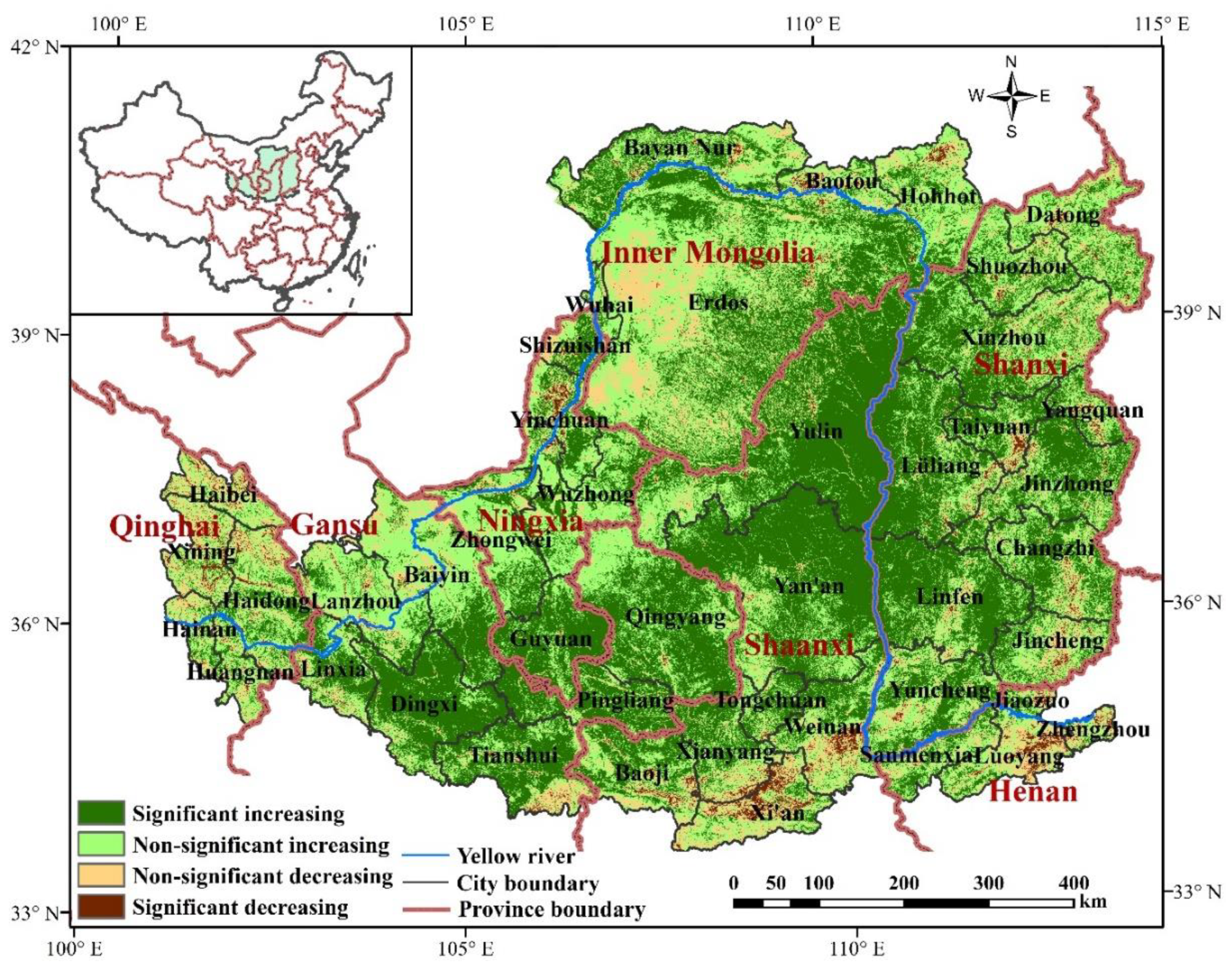
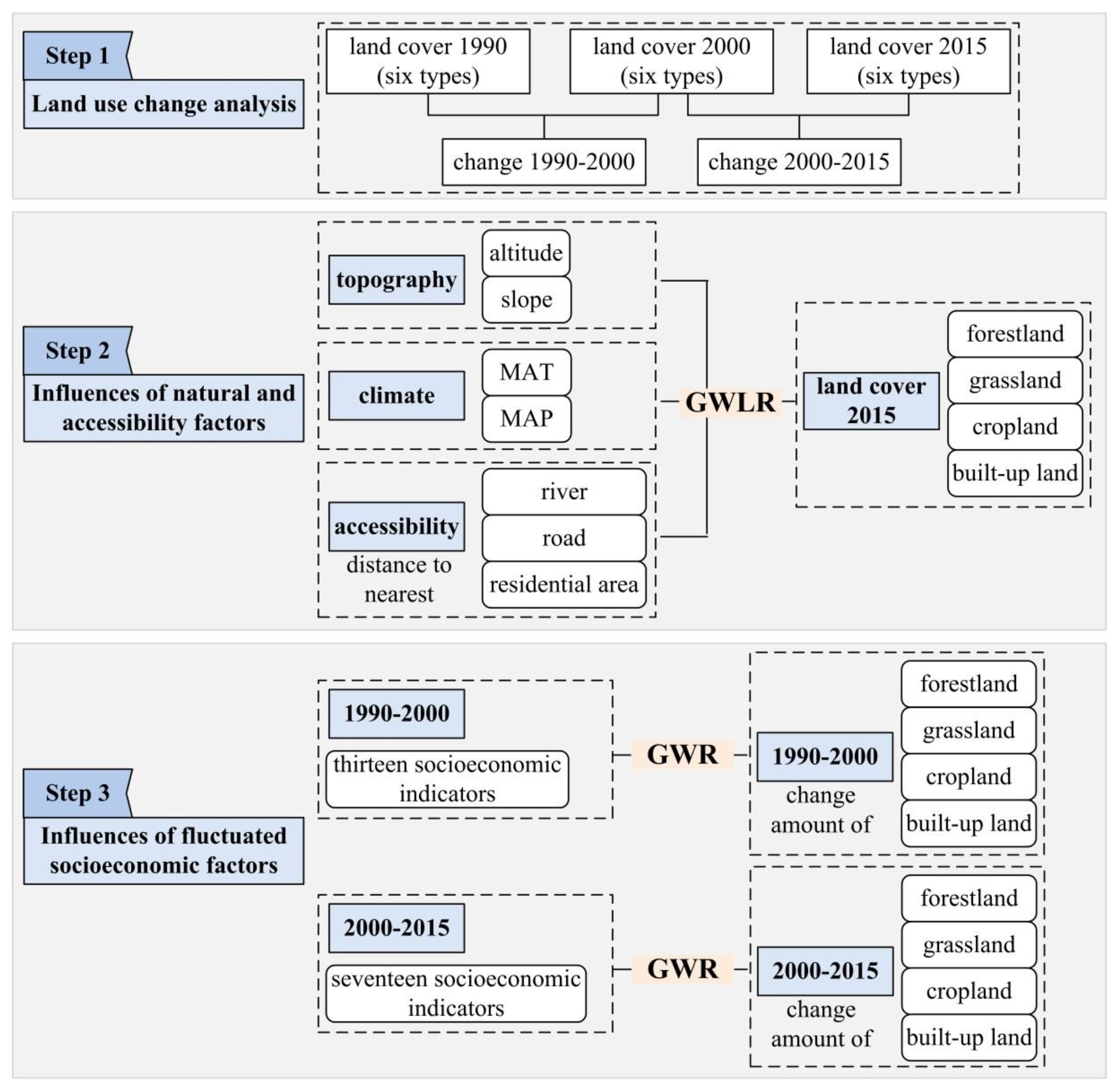
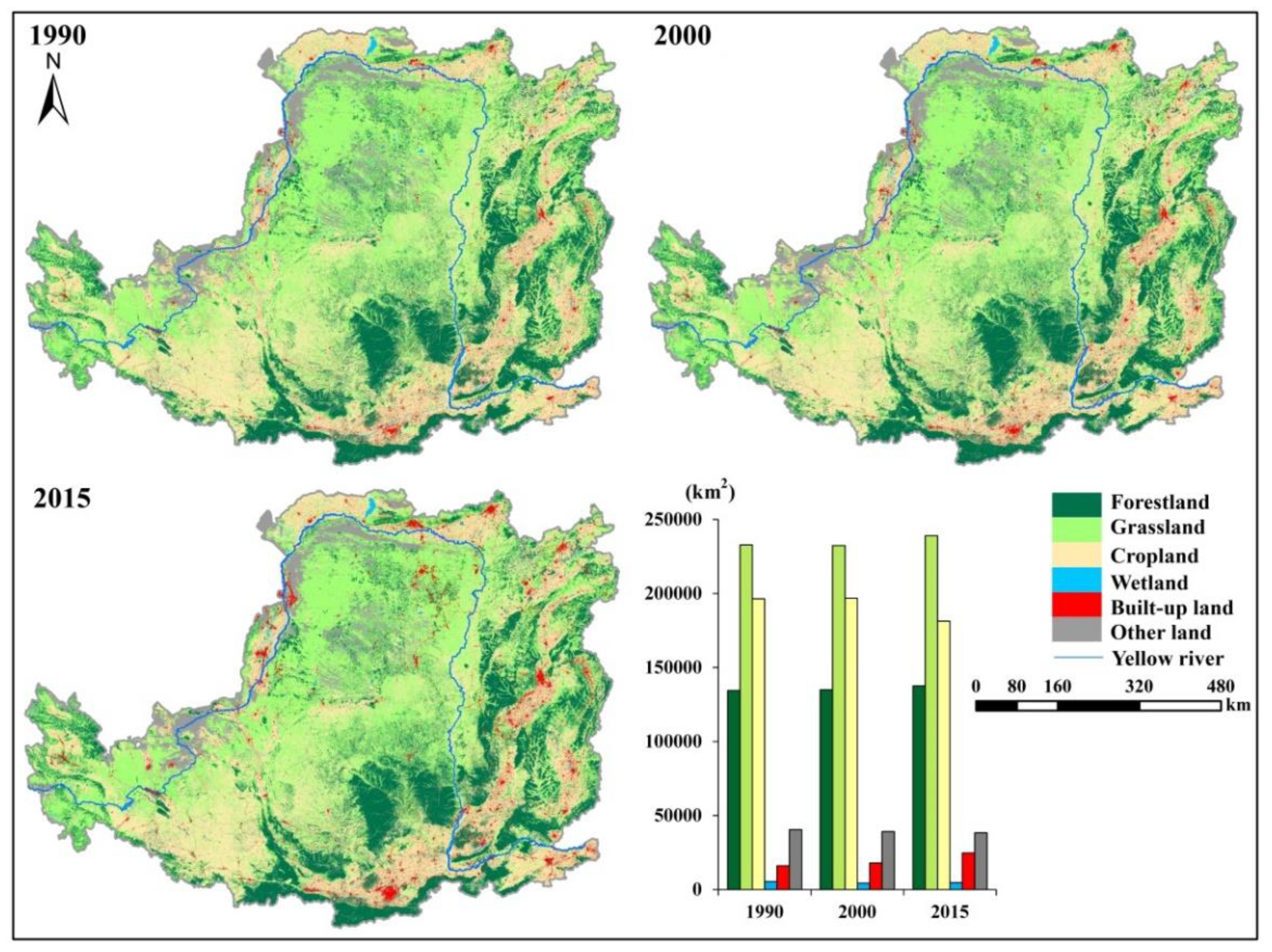
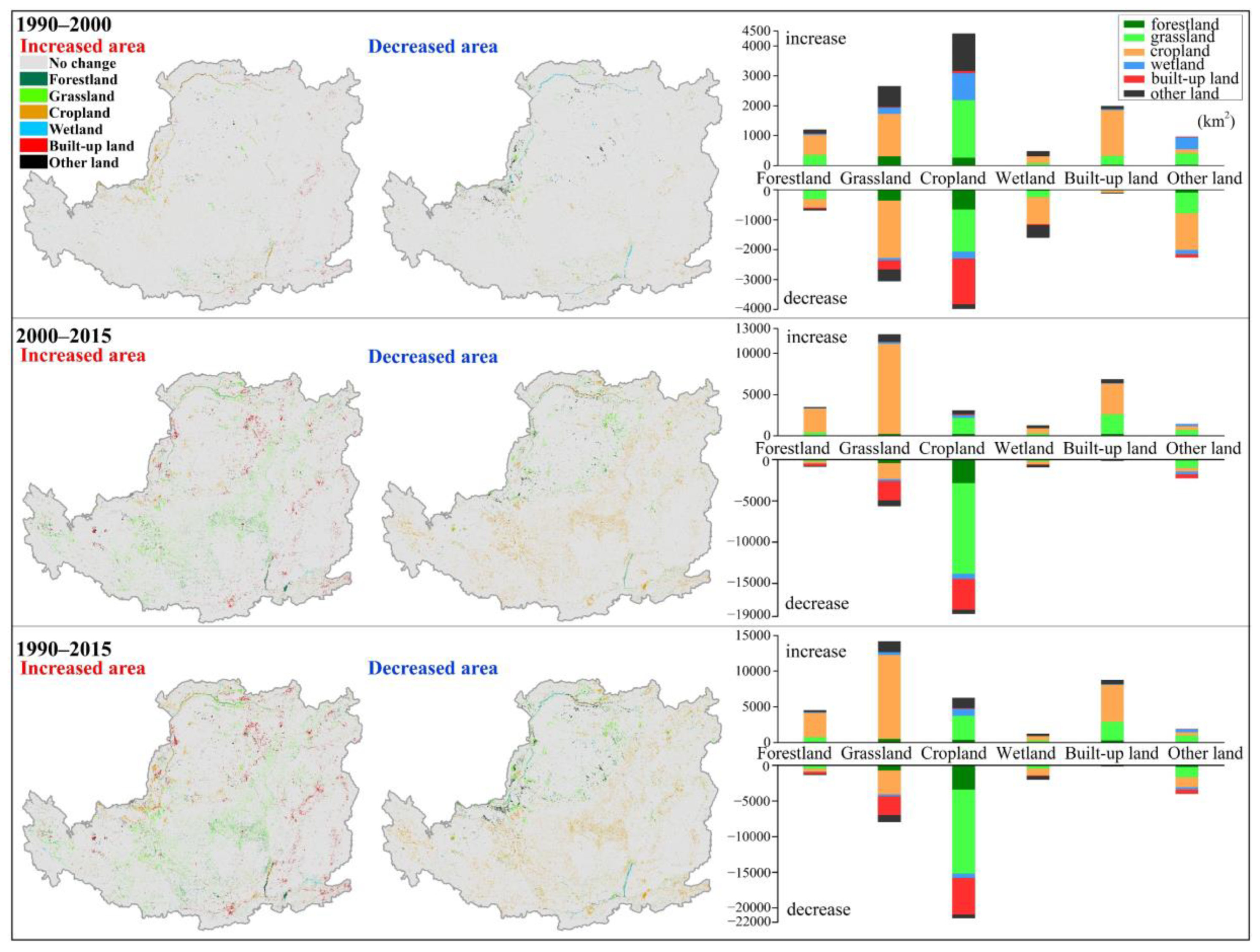

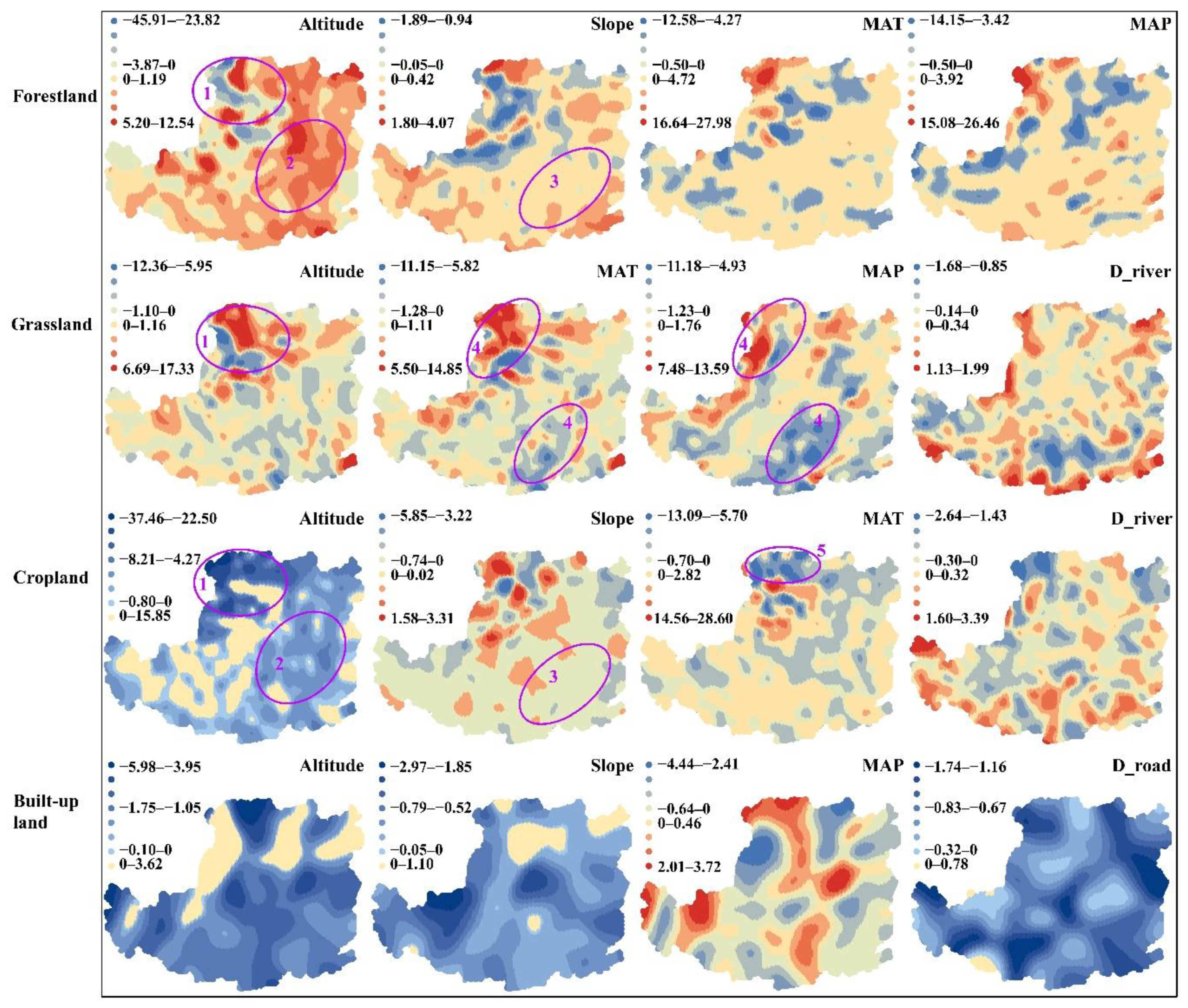
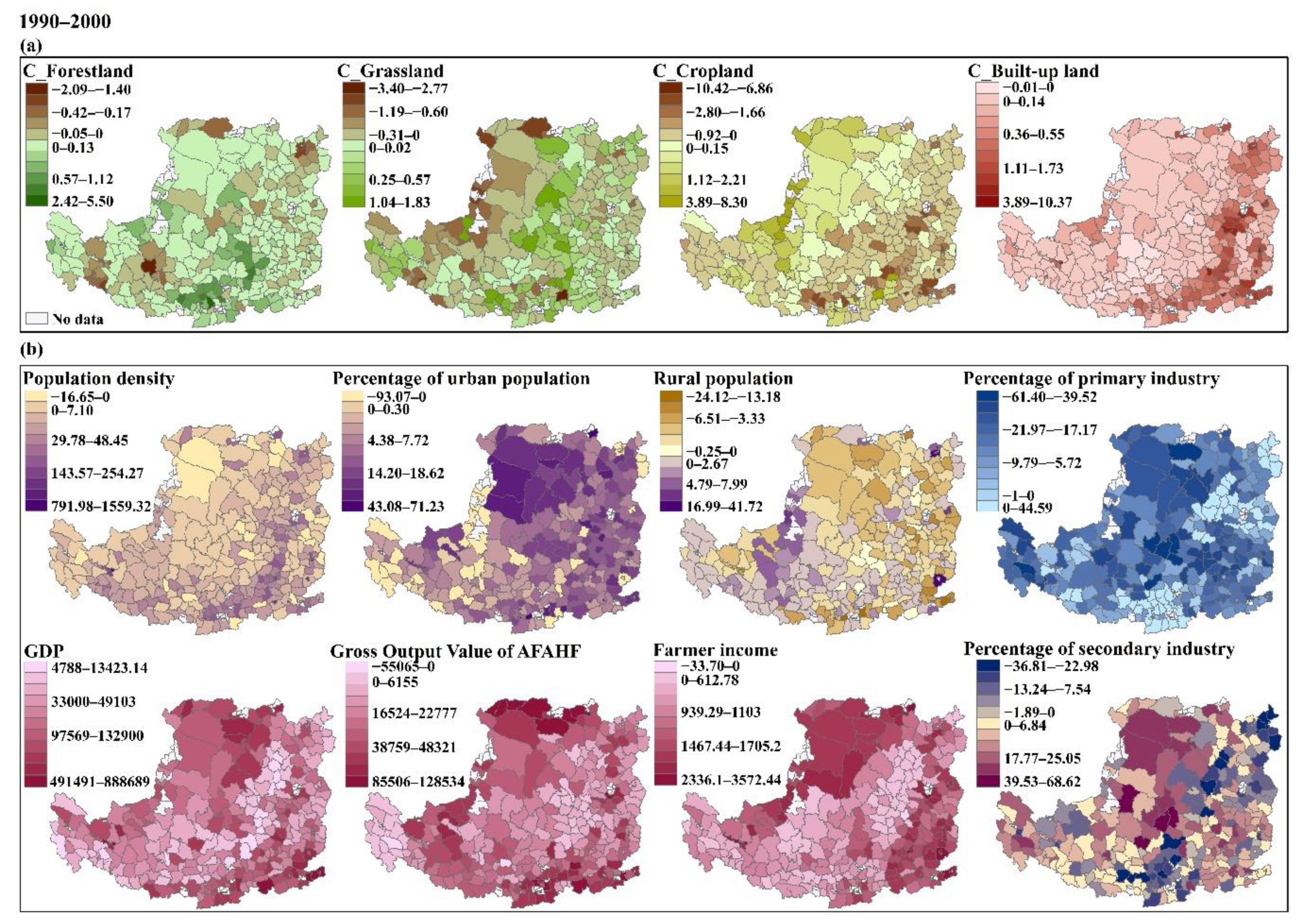
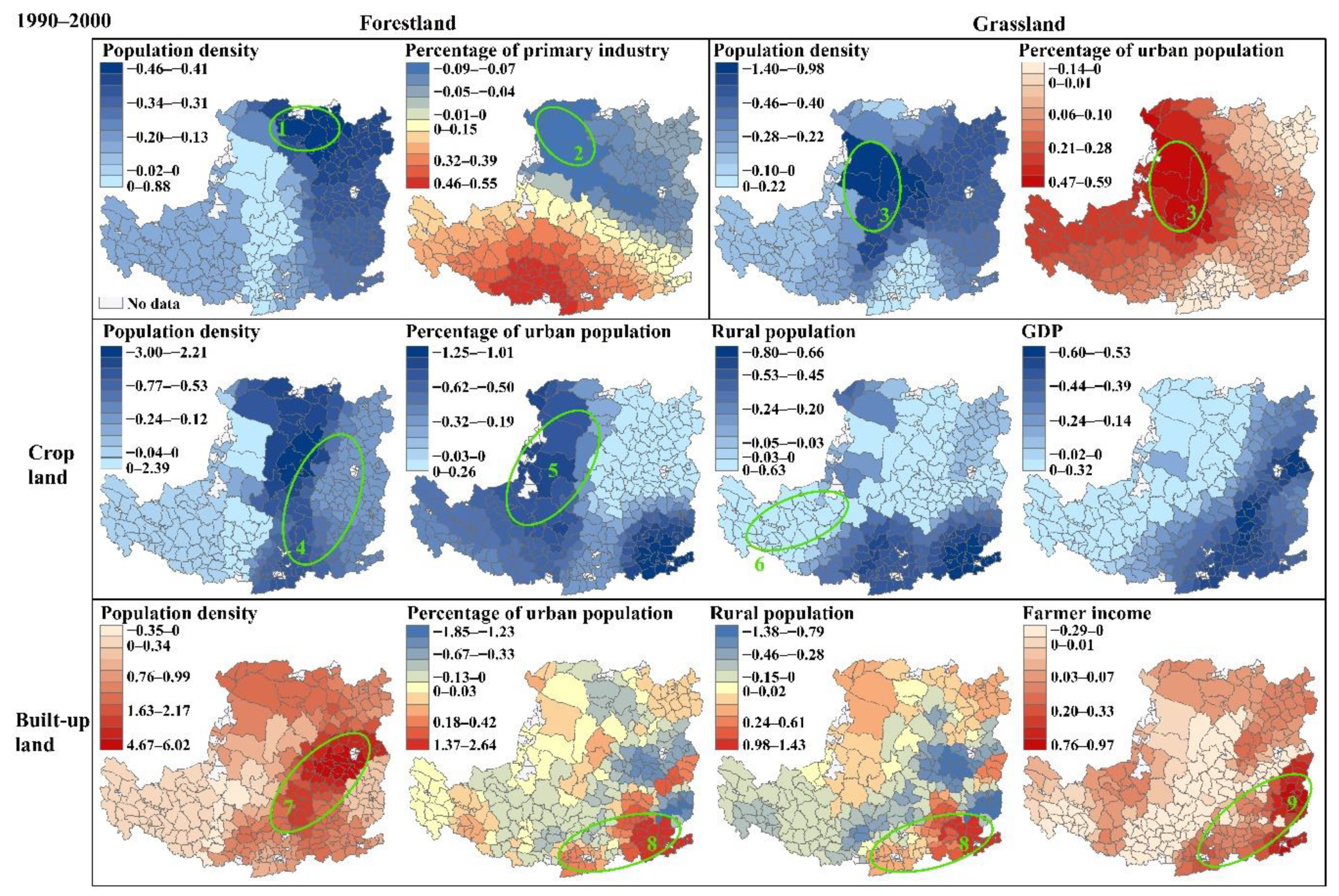
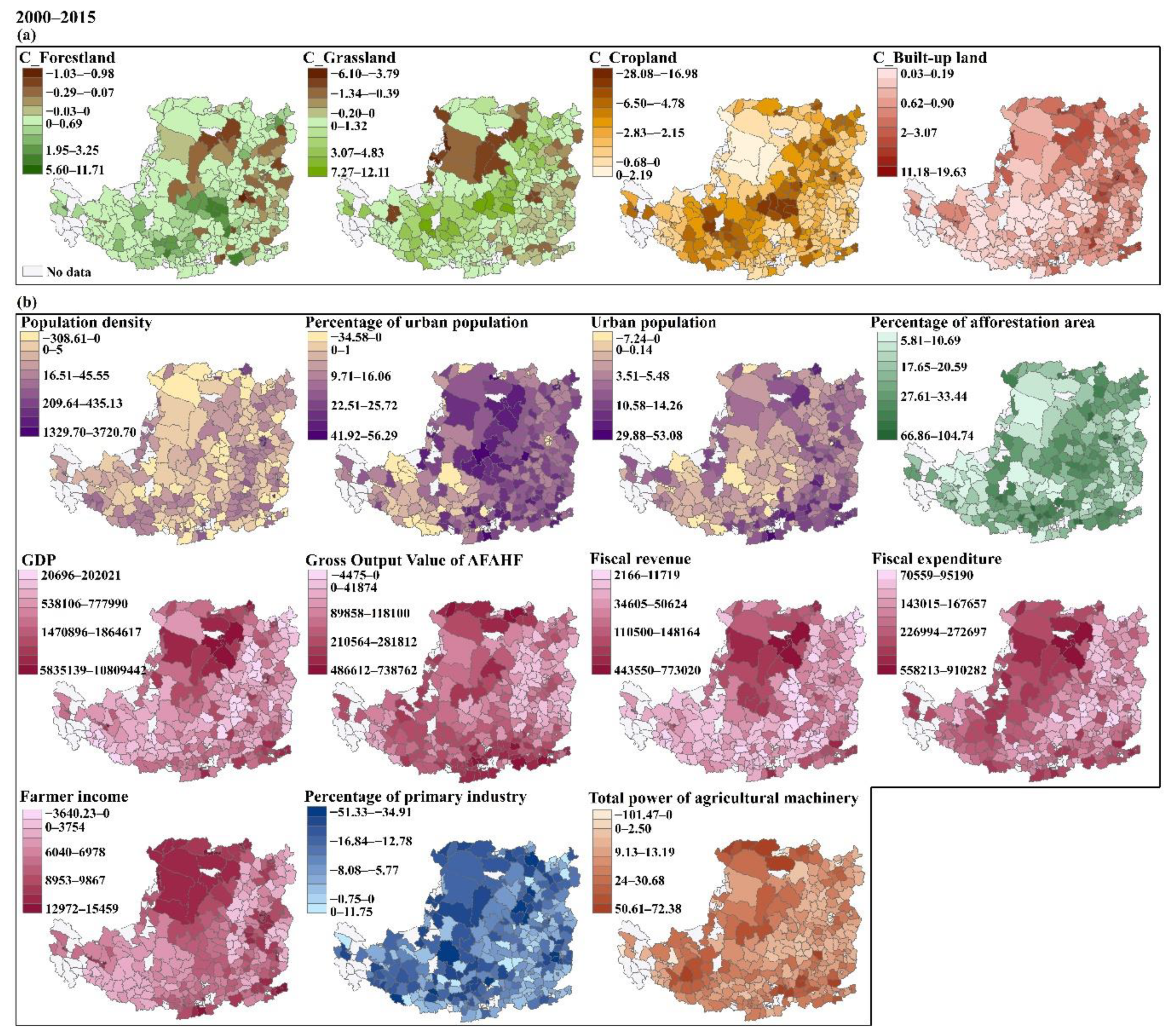
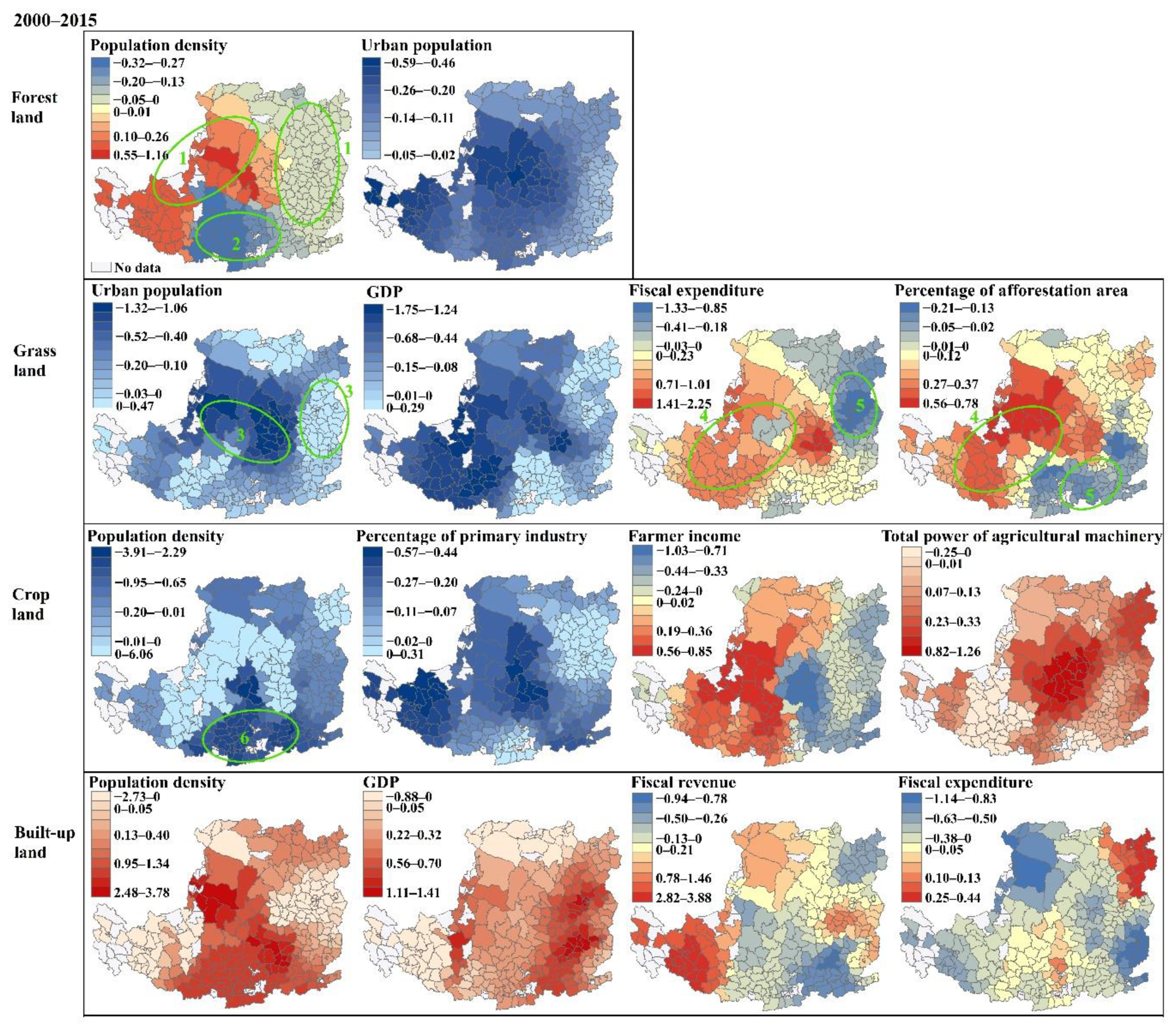
| Data | Description | Source | Preprocessing |
|---|---|---|---|
| NDVI | 250 m resolution Normalized Difference Vegetation Index product; yearly from 2000 to 2015 | Institute of Remote Sensing and Digital Earth, Chinese Academy of Sciences | Least-squares regression for trend detection |
| Land cover/land use | 30 m resolution land-cover product; 1990, 2000 and 2015 | Institute of Remote Sensing and Digital Earth, Chinese Academy of Sciences | Spatial analysis |
| DEM | 30 m resolution Digital Elevation Model | Institute of Remote Sensing and Digital Earth, Chinese Academy of Sciences | Resample |
| MAT | Mean Annual Temperature | National Meteorological Information Center, http://data.cma.cn/ | Calculated from the monthly temperature of the meteorological stations within and around the study region; yearly from 1990 to 2015; spatial interpolation to 1 km resolution |
| MAP | Mean Annual Precipitation | National Meteorological Information Center, http://data.cma.cn/ | Calculated from the monthly precipitation of the meteorological stations within and around the study region; yearly from 1990 to 2015; spatial interpolation to 1 km resolution |
| Accessibility | distance to the nearest river; | 1:1M Geological Map Database of China, http://www.ngac.cn/125cms/c/qggnew/index.htm | Euclidean Distance calculation; 1 km resolution |
| distance to the nearest road; | |||
| distance to the nearest residential areas |
| Indicators | Units | Period | |
|---|---|---|---|
| 1990–2000 1 | 2000–2015 1 | ||
| Dependent variables | |||
| • percentage of forestland against county area | % | ♦ | ♦ |
| • percentage of grassland against county area | % | ♦ | ♦ |
| • percentage of cropland against county area | % | ♦ | ♦ |
| • percentage of built-up land against county area | % | ♦ | ♦ |
| Independent variables | |||
| • total amount of population | 10,000 person | ♦ | ♦ |
| • population density | person/km2 | ♦ | ♦ |
| • percentage of urban population | % | ♦ | ♦ |
| • amount of urban population | 10,000 person | ♦ | ♦ |
| • amount of rural population | 10,000 person | ♦ | ♦ |
| • Gross Domestic Product (GDP) | 10,000 yuan | ♦ | ♦ |
| • GDP per capita | yuan | ♦ | ♦ |
| • percentage of primary industry | % | ♦ | ♦ |
| • percentage of secondary industry | % | ♦ | ♦ |
| • percentage of tertiary industry | % | ♦ | ♦ |
| • fiscal revenue | 10,000 yuan | ♦ | ♦ |
| • fiscal expenditure | 10,000 yuan | × 2 | ♦ |
| • gross output value of agriculture, forestry, animal husbandry and fishery (AFAHF) | 10,000 yuan | ♦ | ♦ |
| • farmer income (per capita) | yuan | ♦ | ♦ |
| • sown area of crops | 1000 ha | × | ♦ |
| • total power of agricultural machinery | 10,000 kw | × | ♦ |
| • cumulative percentage of afforestation area | % | × | ♦2002–2014 |
| Models | Global Logistic Regression | GW Logistic Regression | ||
|---|---|---|---|---|
| AICc | Pseudo R2 | AICc | Pseudo R2 | |
| Forestland | 21,214.05 | 0.19 | 18,136.72 | 0.38 |
| Grassland | 31,268.75 | 0.06 | 27,424.16 | 0.23 |
| Cropland | 27,294.64 | 0.09 | 22,913.48 | 0.31 |
| Built-up land | 7110.92 | 0.13 | 6816.27 | 0.22 |
| Models (1990–2000) | Global Regression | GW Regression | ||
| AICc | Adjusted R2 | AICc | Adjusted R2 | |
| Forestland | 790.39 | 0.07 | 751.62 | 0.20 |
| Grassland | 788.30 | 0.08 | 767.73 | 0.16 |
| Cropland | 766.80 | 0.16 | 659.42 | 0.47 |
| Built-up land | 641.04 | 0.45 | 395.42 | 0.83 |
| Models (2000–2015) | Global Regression | GW Regression | ||
| AICc | Adjusted R2 | AICc | Adjusted R2 | |
| Forestland | 803.76 | 0.06 | 770.05 | 0.19 |
| Grassland | 792.17 | 0.11 | 702.16 | 0.45 |
| Cropland | 777.71 | 0.15 | 725.88 | 0.43 |
| Built-up land | 680.35 | 0.40 | 552.42 | 0.72 |
© 2020 by the authors. Licensee MDPI, Basel, Switzerland. This article is an open access article distributed under the terms and conditions of the Creative Commons Attribution (CC BY) license (http://creativecommons.org/licenses/by/4.0/).
Share and Cite
Ren, Y.; Lü, Y.; Fu, B.; Comber, A.; Li, T.; Hu, J. Driving Factors of Land Change in China’s Loess Plateau: Quantification Using Geographically Weighted Regression and Management Implications. Remote Sens. 2020, 12, 453. https://doi.org/10.3390/rs12030453
Ren Y, Lü Y, Fu B, Comber A, Li T, Hu J. Driving Factors of Land Change in China’s Loess Plateau: Quantification Using Geographically Weighted Regression and Management Implications. Remote Sensing. 2020; 12(3):453. https://doi.org/10.3390/rs12030453
Chicago/Turabian StyleRen, Yanjiao, Yihe Lü, Bojie Fu, Alexis Comber, Ting Li, and Jian Hu. 2020. "Driving Factors of Land Change in China’s Loess Plateau: Quantification Using Geographically Weighted Regression and Management Implications" Remote Sensing 12, no. 3: 453. https://doi.org/10.3390/rs12030453
APA StyleRen, Y., Lü, Y., Fu, B., Comber, A., Li, T., & Hu, J. (2020). Driving Factors of Land Change in China’s Loess Plateau: Quantification Using Geographically Weighted Regression and Management Implications. Remote Sensing, 12(3), 453. https://doi.org/10.3390/rs12030453






